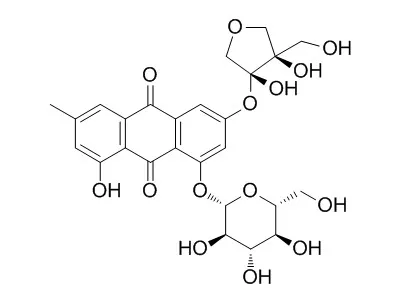| Structure Identification: |
| Planta Medica, 2013, 79(13). | | New HPLC - method to determine Frangulin A and B as well as Glucofrangulin A and B in Frangulae cortex.[Reference: WebLink] | The current monograph in the European Pharmacopeia for Frangulae cortex describes a photometric assay based on an adapted borntrager reaction to determine hydroxyanthracene glycosides, calculated as frangulin B. The method is time consuming, unspecific for frangulines and the precision is not adequate for a modern assay. The photometric method shall therefore be replaced by a modern HPLC-method. There is no HPLC method published in the literature that allows the determination of frangulin A/frangulin B and glucofrangulin A/ Glucofrangulin B in Frangulae cortex.
METHODS AND RESULTS:
About 300 mg of freshly milled drug are extracted for 15 min with ultrasound. The extraction solution consists of acetonitrile/water 50:50 v/v and 2 g/L NaHCO3. A conventional RP C18 Nucleodur (4 mm x 125 mm), 3 µm was used as stationary phase. Mobile phase A consists of water (pH of 2.0, adjusted with phosphoric acid). Mobile phase B consists acetonitrile/methanol 20:80 v/v. The flow rate is 1.0 mL/min, the detection wavelength 435nm, the column temperature is 50 °C, and the injection volume 20µL. The gradient is shown in table 1. The mobile phase separates the four frangulins sufficiently. Results of several samples will be presented on the poster. A chromatogram from a Frangulae cortex sample is shown in figure 1.
CONCLUSIONS:
The method we developed is simple, robust and precise. It is a reasonable option for pharmacopeia applications to replace the outdated photometric assay. | | Zeitschrift für Naturforschung C,1994,49(7-8):404–406. | | Concentrations of Anthraquinone Glycosides of Rumex crispus during Different Vegetation Stages.[Reference: WebLink] |
METHODS AND RESULTS:
The anthraquinone glycoside contents of various parts of Rumex crispus L. (Polygonaceae) in different vegetation stages were investigated by thin layer chromatographic and spectro-photometric methods. The data showed that the percentage of anthraquinone glycoside in all parts of plant increased at each stage. Anthraquinone glycoside content was increased in leaf, stem, fruit and root from 0.05 to 0.40%, from 0.03 to 0.46%, from 0.08 to 0.34%, and from 0.35 to 0.91% respectively.
CONCLUSIONS:
From the roots of R. crispus, emodin-8-glucoside, RGA (isolated in our laboratory, its structure was not elucidated), traceable amount of Glucofrangulin B and an unknown glycoside (Rf = 0.28 in ethyl acetate:m ethanol:water/100:20:10) was detected in which the concentration was increased from May to August. The other parts of plant contained only emodin-8-glucoside |
|






 Cell. 2018 Jan 11;172(1-2):249-261.e12. doi: 10.1016/j.cell.2017.12.019.IF=36.216(2019)
Cell. 2018 Jan 11;172(1-2):249-261.e12. doi: 10.1016/j.cell.2017.12.019.IF=36.216(2019) Cell Metab. 2020 Mar 3;31(3):534-548.e5. doi: 10.1016/j.cmet.2020.01.002.IF=22.415(2019)
Cell Metab. 2020 Mar 3;31(3):534-548.e5. doi: 10.1016/j.cmet.2020.01.002.IF=22.415(2019) Mol Cell. 2017 Nov 16;68(4):673-685.e6. doi: 10.1016/j.molcel.2017.10.022.IF=14.548(2019)
Mol Cell. 2017 Nov 16;68(4):673-685.e6. doi: 10.1016/j.molcel.2017.10.022.IF=14.548(2019)